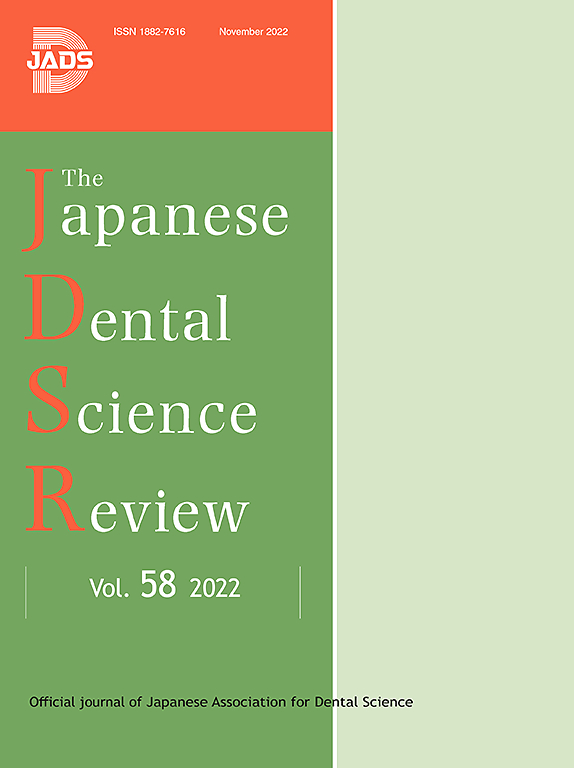牙菌斑引起的口腔疾病与炎症性肠病之间的双向关联:一项系统综述和荟萃分析
IF 5.7
2区 医学
Q1 DENTISTRY, ORAL SURGERY & MEDICINE
引用次数: 0
摘要
牙菌斑引起的口腔疾病与炎症性肠病之间的双向关联尚不清楚。在这里,我们全面检索了PubMed, EMBASE, Web of Science和Cochrane Library从成立到2024年8月的相关研究。将来自牙周病研究的相对危险度(RR)和来自龋齿相关研究的蛀牙、缺牙和补牙(DMFT)指数汇总,并计算95% %置信区间(ci)。采用亚组分析、敏感性分析和累积荟萃分析来评估研究结果的稳健性。该研究遵循PRISMA 2020指南,纳入26项研究进行系统评价,20项进行荟萃分析。结果显示,牙周病患者患炎症性肠病(IBD)的总体风险没有显著增加(RR 1.31, 95 % CI 0.98-1.35);然而,溃疡性结肠炎(UC)的风险高于对照组(RR 1.34, 95 % CI 1.04-1.73)。在IBD患者中,牙周病的风险显著升高(RR 2.14, 95 % CI 1.62-2.81),龋齿的风险也显著升高(WMD = 2.51, 95 % CI 0.97-4.06)。此外,UC患者的龋齿发生率高于克罗恩病(CD)患者(WMD = 3.97, 95 % CI 1.94-6.00)。敏感性分析和累积荟萃分析证实了结果的稳定性。总之,IBD患者,特别是UC患者,应优先考虑严格的口腔卫生,以降低牙周病和龋齿的风险。牙周病和IBD之间的关系需要进一步调查,需要高质量的临床研究来提供更明确和可靠的证据。本文章由计算机程序翻译,如有差异,请以英文原文为准。
Bidirectional association between oral diseases caused by plaque and the inflammatory bowel disease: A systematic review and meta-analysis
The bidirectional association between oral diseases caused by plaque and the inflammatory bowel disease remains unclear. Here, we comprehensively searched PubMed, EMBASE, Web of Science, and the Cochrane Library from inception to August 2024 to identify relevant studies. The relative risk (RR) from periodontal disease studies and the decayed, missing, and filled teeth (DMFT) index from caries-related studies was pooled, and calculating 95 % confidence intervals (CIs). Subgroup analysis, sensitivity analysis, and cumulative meta-analysis were employed to evaluate the robustness of the findings. The research adhered to PRISMA 2020 guidelines, incorporating 26 studies for systematic review and 20 for meta-analysis. The results indicated no significant increase in the overall risk of inflammatory bowel disease (IBD) in patients with periodontal disease (RR 1.31, 95 % CI 0.98–1.35); however, the risk of ulcerative colitis (UC) was higher compared to controls (RR 1.34, 95 % CI 1.04–1.73). Among IBD patients, the risk of periodontal disease was significantly elevated (RR 2.14, 95 % CI 1.62–2.81), as was the risk of dental caries (WMD = 2.51, 95 % CI 0.97–4.06). Additionally, UC patients exhibited a higher incidence of caries compared to Crohn’s disease (CD) patients (WMD = 3.97, 95 % CI 1.94–6.00). Sensitivity analyses and cumulative meta-analyses confirmed the stability of the results. In conclusion, IBD patients, particularly those with UC, should prioritize stringent oral hygiene to mitigate the risks of periodontal disease and dental caries. The association between periodontal disease and IBD warrants further investigation, and high-quality clinical studies are needed to provide more definitive and reliable evidence.
求助全文
通过发布文献求助,成功后即可免费获取论文全文。
去求助
来源期刊

Japanese Dental Science Review
DENTISTRY, ORAL SURGERY & MEDICINE-
CiteScore
9.90
自引率
1.50%
发文量
31
审稿时长
32 days
期刊介绍:
The Japanese Dental Science Review is published by the Japanese Association for Dental Science aiming to introduce the modern aspects of the dental basic and clinical sciences in Japan, and to share and discuss the update information with foreign researchers and dentists for further development of dentistry. In principle, papers are written and submitted on the invitation of one of the Editors, although the Editors would be glad to receive suggestions. Proposals for review articles should be sent by the authors to one of the Editors by e-mail. All submitted papers are subject to the peer- refereeing process.
 求助内容:
求助内容: 应助结果提醒方式:
应助结果提醒方式:


